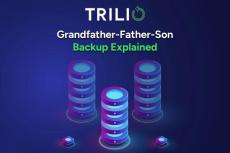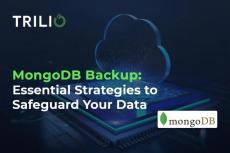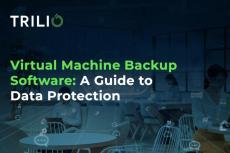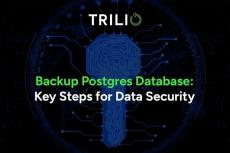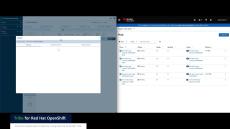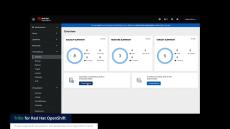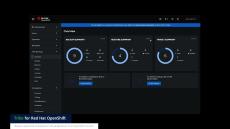|
By Kevin Jackson
With modern businesses increasingly relying on multitenant and multicloud platforms, safeguarding critical data has never been more crucial. Backup as a Service (BaaS) offers a scalable, efficient way to protect valuable assets and ensure business continuity in the face of unexpected incidents.
|
By David Safaii
Traditionally, containers and VMs have operated in separate silos, each with distinct management tools and workflows. OpenShift Virtualization breaks down these barriers, allowing VMs to run alongside containerized applications as native Kubernetes resources. This offers organizations the flexibility to modernize their application stacks incrementally, leveraging existing VM-based workloads while embracing the agility of containers.
|
By Rodolfo Casas
Protecting critical business data requires a reliable backup system that works consistently. The grandfather-father-son (GFS) backup rotation offers a structured approach through organized daily, weekly, and monthly backup cycles. The GFS backup scheme creates multiple recovery points, giving businesses flexibility when restoring data after unexpected issues.
|
By David Safaii
Financial organizations across Europe are actively preparing for the Digital Operational Resilience Act (DORA), taking effect in January 2025. Meeting DORA compliance requirements has become essential for financial institutions as they adjust their operations to match new regulatory standards. The legislation brings substantial changes to information and communication technology (ICT) risk management practices, security protocols, and third-party oversight.
|
By Rodolfo Casas
In my previous blog post, (OpenShift Virtualization Backup and Restore with Trilio in AWS ROSA Baremetal ) I discussed how to protect VMs running in OpenShift Virtualization, specifically in AWS ROSA Baremetal environments. In this post, I want to focus on how you can recover a VM in less than 3 minutes. When it comes to recovery in Kubernetes environments, many of us feel relatively at ease, especially if the Persistent Volumes (PVs) are not particularly large.
|
By Rodolfo Casas
In my previous blog post, (OpenShift Virtualization Backup and Restore with Trilio in AWS ROSA Baremetal ) I discussed how to protect VMs running in OpenShift Virtualization, specifically in AWS ROSA Baremetal environments. In this post, I want to focus on how you can recover a VM in less than 3 minutes. When it comes to recovery in Kubernetes environments, many of us feel relatively at ease, especially if the Persistent Volumes (PVs) are not particularly large.
|
By Kevin Jackson
Data drives businesses forward, and MongoDB has become a critical database solution for many companies. But what if disaster strikes? That’s where MongoDB backup becomes essential.
|
By David Safaii
Organizations face mounting pressure as their data storage needs multiply each year. The challenge lies in managing vast amounts of information that must be preserved but rarely sees active use. Cold data storage offers a smart solution for storing this infrequently accessed data while keeping costs under control. Cold storage systems excel at housing compliance archives, historical records, and backup files, all while maintaining accessibility when these assets are needed.
|
By Rodolfo Casas
Virtual machines form the backbone of most enterprise IT systems, which means effective virtual machine backup software is essential for safeguarding business operations. Companies need reliable backup solutions to protect their virtualized applications and data from unexpected failures, breaches, or system crashes.
|
By Kevin Jackson
If you manage customer information, financial records, or business intelligence, learning how to backup Postgres databases effectively is a must-have skill. This guide offers practical steps to secure your data, covering various backup types and strategies to keep your information safe and recoverable. We show you how to create a solid backup plan for your Postgres databases, reducing downtime risks and safeguarding your organization’s most valuable asset.
|
By Trilio
Experience Taikun CloudWorks Kubernetes Management with Trilio for Backup and Recovery.
|
By Trilio
Welcome to this short video on using a new feature of Trilio for OpenStack to migrate VMware VMs to OpenStack. In this video, I will demonstrate how we will migrate a couple of CentOS VMs to my Red Hat OpenStack Platform cluster. Trilio for OpenStack integrates into the Horizon experience, and from here we can launch the VMware Migration plugin to create a Migration Plan.
|
By Trilio
(With Audio) See how easy it is to protect a newly deployed application into OpenShift using Red Hat Ansible Automation Platform, followed by an ACM Policy written for Trilio that will auto protect the deployed application (create a backup, according to the policy) In this video we will show you an example of using Red Hat Advanced Cluster Management (or ACM) and Trilio to automatically back up an application that has just been deployed.
|
By Trilio
Use the Trilio UI to Restore your OpenShift Virtualization Virtual Machines. In this video we will show you how to restore a previously backed up virtual machine running in OpenShift using Trilio As we are restoring a virtual machine to the same cluster that we backed up earlier, we can use the Trilio User Interface to simply list the deployed virtual machines, and see that the status of the last backup is marked as Available for this virtual machine.
|
By Trilio
Use the Trilio UI to Backup your OpenShift Virtualization Virtual Machines. In this video we will show you how to backup individual virtual machines from OpenShift using Trilio. First we are going to log in to the Trilio User Interface using our OpenShift credentials. Trilio has a Backup Wizard that allows you to select your individual VMs that you have access to in your cluster. We’ll select this Virtual Machine and click Next.
|
By Trilio
Use the Trilio UI to Backup your OpenShift Virtualization Virtual Machines. This video has no sound.
|
By Trilio
Use the Trilio UI to Restore your OpenShift Virtualization Virtual Machines. This video has no sound.
|
By Trilio
See how easy it is to protect a newly deployed application into OpenShift using Red Hat Ansible Automation Platform, followed by an ACM Policy written for Trilio that will auto protect the deployed application (create a backup, according to the policy)
|
By Trilio
Backup your OpenShift Virtualization VMs directly from the OpenShift Console using Trilio.
|
By Trilio
Restore your OpenShift Virtualization Virtual Machines using Trilio integrated into the OpenShift Console.
|
By Trilio
The Broadcom acquisition of VMware has triggered a strategic shift for cloud deployments. Organizations are increasingly concerned about vendor lock-in and potential cost increases, prompting them to explore alternative solutions. This report analyzes the opportunity for migrating workloads from VMware to OpenStack, outlining key decision points and best practices for a successful transition.
- February 2025 (2)
- January 2025 (5)
- December 2024 (2)
- November 2024 (2)
- October 2024 (4)
- September 2024 (2)
- August 2024 (3)
- July 2024 (5)
- June 2024 (2)
- May 2024 (3)
- April 2024 (7)
- March 2024 (4)
- February 2024 (3)
- October 2023 (5)
- September 2023 (3)
- March 2023 (3)
- February 2023 (4)
- January 2023 (1)
Purpose built for the cloud-native era, Trilio protects the most demanding environments to maximize stability across all tenants.
Cloud-Native by Design:
- Intelligent Recovery for Kubernetes Apps: Intelligent, enterprise-grade cloud-native protection for Red Hat, Canonical, Mirantis, Vmware, Nutanix, EKS, AKS, GKE, Suse, and other CNCF-compliant Kubernetes distributions.
- Intelligent Recovery for OpenStack: Restore entire workloads with a single click and get complete visibility into OpenStack operations in a single view with the only backup and recovery solution built for TripleO, Red Hat OSP, Mirantis OpenStack, Canonical, Ansible, Kolla, Rackspace OpenStack.
- Red Hat® OpenShift®: A unified platform to build, modernize, and deploy applications at scale. Work smarter and faster with a complete set of services for bringing apps to market on your choice of infrastructure.
Kubernetes, KubeVirt and OpenStack Multi-Cluster Data Protection and Intelligent Recovery




